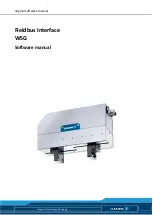
Commands
01.00|WSG |en
15
GRASP - Grasp a part
Grasp a part using its nominal width, the speed and the force limit
at which the part should be grasped.
When the command is issued, the gripper moves its fingers to the no-
minal part width and tries to clamp the expected part with the pre-
viously set grasping force. If the gripper can establish the desired
grasping force within the defined clamping travel, a part is grasped. If
the fingers fall through the clamping travel without establishing the
grasping force, no part was found and the grasping state is updated
accordingly. The clamping travel can be set using the WSG’s web inter-
face. The grasping state is updated with the result of this operation (ei-
ther PART_HOLDING or NO_PART) as well as the grasping statistics. If
no part was found, the command’s result is set to E_CMD_FAILED.
After successfully grasping a part, the integrated part monitoring is
enabled which supervises the grasping force. If a part is removed
from the gripper before issuing the RELEASE command, the gripper
detects it and changes the grasping state to PART_LOST.
NOTE
You may reduce the grasping speed with sensitive parts to limit
the impact due to the mass of the gripper fingers and the internal
mechanics.
Command Flag Position:
Bit 1
Parameters used:
WIDTH, SPEED, FORCELIMIT
Status Code:
The STATUS CODE register is set to E_CMD_PENDING upon start of
the movement and set to the command’s result when it has finished.
Grasping State (GSTATE):
During finger movement, the grasping state is set to GRASPING. If
a part was found, it changes to HOLDING. If no part was found, the
Grasping State is set to NO_PART. If a part was removed after it
was clamped, the grasping state is set to PART_LOST. In case of an
error, the grasping state is set to ERROR.
System State (SYSSTATE):
Various transitions will occur. You should use the GSTATE register
to evaluate the current state of the grasping process, unless you
have very special requirements.
4.2














































